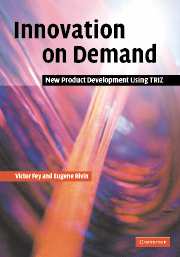Altshuller, G. S. (1963). How to solve scientific problems, preprint, Baku (in Russian)
Altshuller, G. S. (1984). To Find an Idea. Novosibirsk: Nauka, p. 69 (in Russian)
Altshuller, G. S. (1988a). Small unbounded worlds. In: A Thread in the Labyrinth. Petrozavodsk: Karelia, pp. 165–230 (in Russian)
Altshuller, G. S. (1988b). Creativity as an Exact Science. New York: Gordon and Breach
Altshuller, G. S. (1994). And Suddenly the Inventor Appeared. Worcester, MA: Technical Innovation Center
Altshuller, G. S. (1997). 40 Principles: TRIZ Keys to Technical Innovation. Worcester, MA: Technical Innovation Center
Altshuller, G. S. (1999). The Innovation Algorithm.Worcester, MA: The Altshuller Institute for TRIZ Studies
Altshuller, G. S., Shapiro, R. B. (1956). On the psychology of engineering creativity. Problems of Psychology, 6 37–49 (in Russian)
Altshuller, G. S., Vertkin, I. M. (1994). How to Become a Genius: The Life Strategy of a Creative Person. Minsk: Belarus (in Russian)
Altshuller, G., Gadzhiev, Ch., Flikshtein, I. (1973). Introduction to Sufield Analysis.Baku, USSR: The Public Laboratory for the Theory of Invention (in Russian)
Astashev, V. K., Babitsky, V. I. (1998). Ultrasonic cutting as a nonlinear (vibro-impact) process. Ultrasonics, 36, 89–96
Banks, H. T., Smith, R. C., Wang, Y. (1996). Smart Material Structures: Modeling, Estimation and Control. New York: John Wiley & Sons
Bassala, G. (1988). The Evolution of Technology. Cambridge: Cambridge University Press
Brown, S., Rose, J. (1996). FPGA and CPLD architecture: a tutorial. IEEE Design and Test of Computers, Summer 1996, 42–57
Cole, W. (2002). Let's twist again! Technology that enables wing ‘warping’ rolled out at Dryden. Boeing Frontiers Online, Volume 1, Issue 1, May 2002, http://www.boeing.com/news/frontiers/archive/2002/may
Cusumano, M. A., Markides, C. C. (eds.) (2001). Strategic Thinking for the Next Economy. Boston: Jossey-Bass, p. 159
Davis, T., Sasser, M. (1995). Postponing product differentiation. Mechanical Engineering, No. 11, pp. 105–107
Drexler, K. E. (1992). Nanosystems: Molecular Machinery, Manufacturing, and Computation. New York: John Wiley & Sons
Edwards, B., Cox, C. (2002). Revolutionary concepts for helicopter noise reduction – S.I.L.E.N.T. Program, in NASA/CR-2002-211650, May 2002
Fey, V. R. (1988). Chronokinematics of Technological Systems. Baku, USSR: The Laboratory for the Theory of Invention
Fey, V., Bodine, N., Rivin, E. (2001). A strategy for effective technology investment. http://trizgroup.com/publications/articles/strategy.pdf
Feynman, R. P. (1959). There's plenty of room at the bottom: an invitation to enter a new field of physics. http://www.zyvex.com/nanotech/feynman.html
Field, F. R., Clark, J. P. (1997). A practical road to lightweight cars, MIT Technology Review, September
Filkovsky, G. L. (1974). A Scientific Theory as a Machine, preprint, Baku (in Russian)
Forbes, S. (1997). Fact and comment: plane to see. Forbes Magazine, March 10
Glasmeier, A. (1997). Technological discontinuities and flexible production networks: the case of Switzerland and the world watch industry. In: Managing Strategic Innovation and Change. Oxford: Oxford University Press, pp. 32–33
Jain, V. K. (2002). Advanced fine finishing processes. http://www.geocities.com/aimtdr20th/keynote/jain.PDF
Kada, M., Smith, L. (2000). Advancements in stacked chip scale packaging (S-CSP) provide system-in-a-package functionality for wireless and handheld applications. In: Proceedings of Pan Pacific Microelectronics Symposium Conference
Leifer, R., McDermott, C. M., O'Connor, G. C.et al. (2000). Radical Innovation: How Mature Companies Can Outsmart Upstarts. Boston: Harvard Business School Press
Lown, B. (1996), The Lost Art of Healing. Boston-N.Y.: Houghton Miffin Co
Lynn, G. S., Morone, J. G., Paulson, A. S. (1997). Marketing and discontinuous innovation: the probe and learn process. In: Managing Strategic Innovation and Change. New York: Oxford University Press, p. 357
Malinovsky, G. T. (1988). Oil-based Coolants. Moscow, Russia: Chemistry (in Russian).
Mann, D. (2002). Hands-on Systematic Innovation. Belgium: CREAX Press Leper.
McGrath, C., McCormick, D. (2002). The Ultimate Golf Book: A History and a Celebration of the World's Greatest Game. New York: Houghton Mifflin Company
McGraw, D. (1996). Staying loose in a tense tech market. U.S. News and World Report, July 8, p. 46
McNeil, B. (2002). Manual windshield wiper conversion and repair. http://www.film.queensu.ca/CJ3B/Tech/WiperManual.html
Merkle, R. C. (1997). It's a small, small, small world. MIT Technology Review, February/March, pp. 25–32
Moisan, M., Shivarova, A., Trivelpiece, A. W. (1982). Experimental investigations of the propagation of surface waves along a plasma column. Plasma Physics, 24, No. 11, 1331–1400.
Nolas, G. S., Sharp, J., Goldsmid, H. J. (2001). Thermoelectrics: Basic Principles and New Materials Developments. New York: Springer-Verlag
Papazian, J. (2002). Tools of change. http://www.memagazine.org/backissues/feb02/features/toolsof/toolsod.html
Penzias, A. A. (1997). The next fifty years: some likely impacts of solid-state technology. Bell Labs Technical Journal, Autumn, p. 156
Rantanen, K., Domb, E. (2002). Simplified TRIZ: New Problem-Solving Applications for Engineers and Manufacturing Professionals. Boca Raton, FL: St. Lucie Press
Raskin, A. (2003). A higher plane of problem solving. Business, 2.0, June, pp. 54–57
Rediniotis, O. I., Wilson, L. N., Lagoudas, D. C., Khan, M. M. (2002). Development of a shape-memory-alloy actuated biomimetic hydrofoil. Journal of Intelligent Material Systems and Structures, 13 (January), 35–49
Rivin, E. I. (1998). Mechanical Design of Robots, New York: McGraw-Hill.
Rivin, E. I. (1999). Stiffness and Damping in Mechanical Design. New York: Marcel Dekker, pp. 52– 86.
Talanquer, V. (2002). Nucleation in gas–liquid transitions. Journal of Chemical Education, 79, No. 7, 877–83
Tate, K., Domb, E. (1997). 40 Inventive Principles with Examples. http://www.triz-journal.com/archives/1997/07/b/index.html
Taylor, M. B., Kim, J., Miller, J.et al. (2002). The raw microprocessor: a computational fabric for software circuits and general purpose programs. IEEE Micro, Mar–April, pp. 25–35
Travers, B. (ed.) (1995). World of Invention. Farmington Hills, MI: Gale, p. 635
Tsugawa, S. (2000). An introduction to Demo 2000: the cooperative driving scenario. IEEE Intelligent Systems, 15, No. 4, 78–9
Vertkin, I. M. (1984). Mechanisms of Convolution of Technological Systems. Baku, USSR: The Public Laboratory for the Theory of Invention (in Russian).
Volti, R. (1996). A century of automobility. Technology and Culture, 37, No. 4, 663–85
Walczyk, D. F., Hardt, D. E. (1998). Design and analysis of reconfigurable discrete dies for sheet metal forming. SME Journal of Manufacturing Systems, 17, No. 6, 436–454.
Wlezien, R. W., Horner, G. C., McGowan, A. R.et al. (1998). The aircraft morphing program. In: Proceedings of the SPIE Smart Structures and Materials Symposium, Industrial and Commercial Applications Conference, Vol. 3326, paper 3326–20





